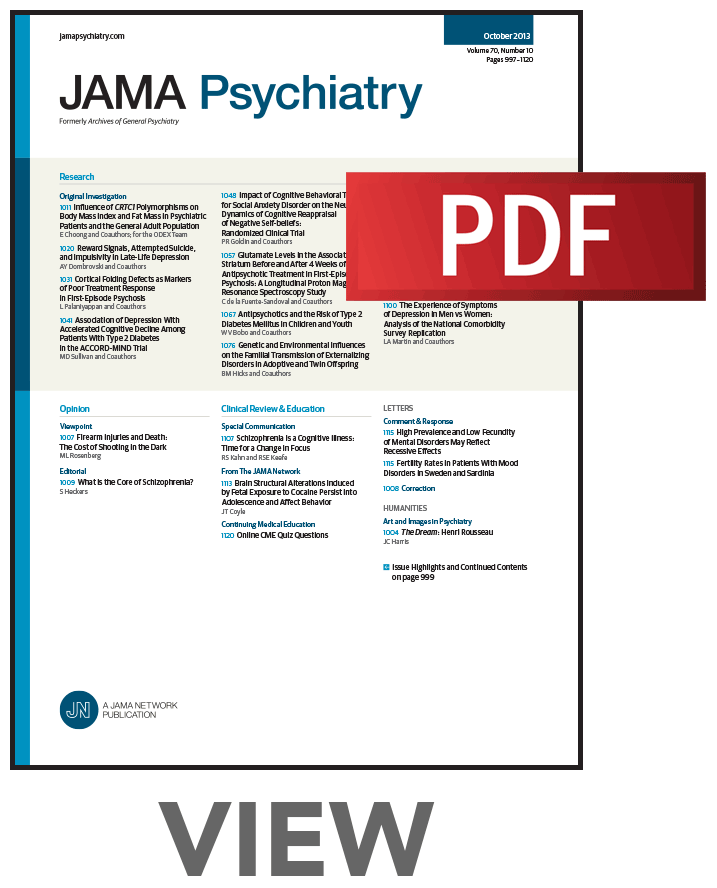艾氯胺酮单药治疗成人难治性抑郁症:一项随机临床试验
IF 17.1
1区 医学
Q1 PSYCHIATRY
引用次数: 0
摘要
艾氯胺酮鼻喷雾剂与口服抗抑郁药联合使用,已被批准用于治疗难治性抑郁症(TRD)。然而,艾氯胺酮鼻腔喷雾剂单药治疗TRD患者的疗效尚未得到评价。目的评价艾氯胺酮单药治疗与安慰剂相比减轻TRD患者抑郁症状的疗效和安全性。设计、环境和参与者这项4期、双盲、安慰剂对照的随机临床试验于2020年11月至2024年1月在美国的51个门诊中心进行。无精神病性特征的成人重度抑郁症(DSM-5标准),在当前抑郁发作期间对2种或更多口服抗抑郁药反应不足(改善≤25%),符合纳入条件。数据分析时间为2024年3月1日至2024年7月8日。干预措施:在2周或更长时间的无抗抑郁期后,参与者按1:1:2的比例随机分配到固定剂量的鼻内艾氯胺酮(56 mg或84 mg)或匹配的鼻内安慰剂,每周两次,持续4周。蒙哥马利-Åsberg抑郁评定量表(MADRS)评分从基线到第28天(主要疗效终点)和第一次给药后24小时(第2天;关键次要疗效终点)采用重复测量的混合效应模型进行分析。结果在这项多中心随机临床试验中,378名符合随机化前MADRS严重程度标准的参与者接受了1次或更多剂量的研究药物(艾氯胺酮,56 mg [n = 86];艾氯胺酮84 mg [n = 95];或安慰剂[n = 197])。参与者平均(SD)年龄为45.4(14.1)岁,231名参与者(61.1%)为女性,基线平均(范围)MADRS总分为37.3(28-50)。在第28天,56毫克剂量的埃氯胺酮和安慰剂之间的最小二乘(LS)平均差(SE)为-5.1 (1.42)(95% CI, -7.91至-2.33),84毫克剂量的最小二乘平均差(SE)为-6.8 (1.38)(95% CI, -9.48至-4.07)(各双侧P < .001)。56 mg和84 mg剂量组的效应值分别为0.48和0.63。在第2天(首次给药后约24小时),两种剂量的埃氯胺酮组间差异均显著:-3.8 (1.29)(95% CI, -6.29至-1.22;56 mg的双侧P = 0.004)和-3.4 (1.24)(95% CI, -5.89至-1.00;双侧P = 0.006)。据报道,埃氯胺酮(联合剂量)最常见的治疗不良事件是恶心(56例[24.8%])、游离(55例[24.3%])、头晕(49例[21.7%])和头痛(43例[19.0%])。结论和相关性根据这项多中心、双盲随机临床试验的结果,艾氯胺酮单药治疗可以通过解决口服抗抑郁药治疗限制耐受性和无反应的患者的未满足需求,扩大成年TRD患者的治疗选择。临床试验注册号:NCT04599855。本文章由计算机程序翻译,如有差异,请以英文原文为准。
Esketamine Monotherapy in Adults With Treatment-Resistant Depression: A Randomized Clinical Trial.
Importance
Esketamine nasal spray, administered in conjunction with an oral antidepressant, is approved for treatment-resistant depression (TRD). However, the efficacy of esketamine nasal spray administered as monotherapy for patients with TRD has not yet been evaluated.
Objective
To assess the efficacy and safety of esketamine monotherapy compared to placebo in reducing depressive symptoms in patients with TRD.
Design, Setting, and Participants
This phase 4, double-blind, placebo-controlled randomized clinical trial was conducted from November 2020 to January 2024 at 51 outpatient centers in the US. Adults with major depressive disorder (DSM-5 criteria) without psychotic features who experienced inadequate response (≤25% improvement) to 2 or more oral antidepressants during the current depressive episode were eligible for inclusion. Data analyses were conducted from March 1, 2024, to July 8, 2024.
Interventions
After a 2-week or longer antidepressant-free period, participants were randomized at a 1:1:2 ratio to fixed-dose intranasal esketamine (56 mg or 84 mg) or matching intranasal placebo, administered twice weekly for 4 weeks.
Main Outcomes and Measures
Change in Montgomery-Åsberg Depression Rating Scale (MADRS) score from baseline to day 28 (primary efficacy end point) and to 24 hours post-first dose (day 2; key secondary efficacy end point) were analyzed by a mixed-effects model using repeated measures.
Results
In this multicenter randomized clinical trial, 378 participants who met prerandomization MADRS severity criteria received 1 or more study drug doses (esketamine, 56 mg [n = 86]; esketamine, 84 mg [n = 95]; or placebo [n = 197]). Mean (SD) participant age was 45.4 (14.1) years, 231 participants (61.1%) were female, and baseline mean (range) MADRS total score was 37.3 (28-50). At day 28, the least-square (LS) mean difference (SE) between esketamine and placebo was -5.1 (1.42) (95% CI, -7.91 to -2.33) for the 56-mg dose and -6.8 (1.38) (95% CI, -9.48 to -4.07) for the 84-mg dose (for each, 2-sided P < .001). Observed effect sizes were 0.48 and 0.63 for the 56-mg and 84-mg dose groups, respectively. At day 2 (approximately 24 hours post-first dose), the between-group difference was significant for both esketamine doses: -3.8 (1.29) (95% CI, -6.29 to -1.22; 2-sided P = .004) for 56 mg and -3.4 (1.24) (95% CI, -5.89 to -1.00; 2-sided P = .006) for 84 mg. The most common treatment-emergent adverse events reported for esketamine (combined doses) were nausea (56 participants [24.8%]), dissociation (55 [24.3%]), dizziness (49 [21.7%]), and headache (43 [19.0%]).
Conclusions and Relevance
According to results of this multicenter, double-blind randomized clinical trial, esketamine monotherapy may expand treatment options for adult patients with TRD by addressing an unmet need of patients experiencing treatment-limiting tolerability concerns and nonresponse with oral antidepressants.
Trial Registration
ClinicalTrials.gov Identifier: NCT04599855.
求助全文
通过发布文献求助,成功后即可免费获取论文全文。
去求助
来源期刊

JAMA Psychiatry
PSYCHIATRY-
CiteScore
30.60
自引率
1.90%
发文量
233
期刊介绍:
JAMA Psychiatry is a global, peer-reviewed journal catering to clinicians, scholars, and research scientists in psychiatry, mental health, behavioral science, and related fields. The Archives of Neurology & Psychiatry originated in 1919, splitting into two journals in 1959: Archives of Neurology and Archives of General Psychiatry. In 2013, these evolved into JAMA Neurology and JAMA Psychiatry, respectively. JAMA Psychiatry is affiliated with the JAMA Network, a group of peer-reviewed medical and specialty publications.
 求助内容:
求助内容: 应助结果提醒方式:
应助结果提醒方式:


